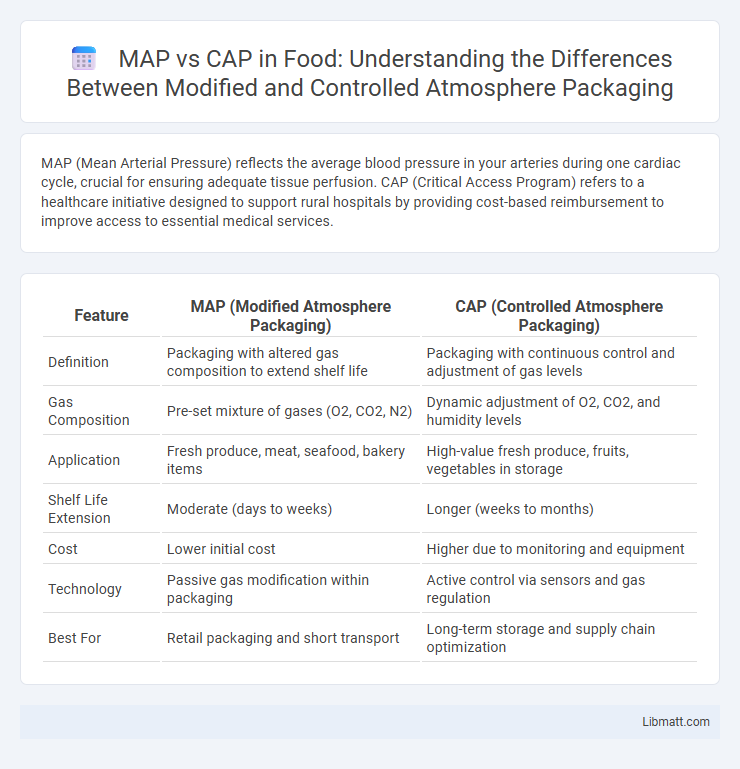MAP (Mean Arterial Pressure) reflects the average blood pressure in your arteries during one cardiac cycle, crucial for ensuring adequate tissue perfusion. CAP (Critical Access Program) refers to a healthcare initiative designed to support rural hospitals by providing cost-based reimbursement to improve access to essential medical services.
Table of Comparison
| Feature | MAP (Modified Atmosphere Packaging) | CAP (Controlled Atmosphere Packaging) |
|---|---|---|
| Definition | Packaging with altered gas composition to extend shelf life | Packaging with continuous control and adjustment of gas levels |
| Gas Composition | Pre-set mixture of gases (O2, CO2, N2) | Dynamic adjustment of O2, CO2, and humidity levels |
| Application | Fresh produce, meat, seafood, bakery items | High-value fresh produce, fruits, vegetables in storage |
| Shelf Life Extension | Moderate (days to weeks) | Longer (weeks to months) |
| Cost | Lower initial cost | Higher due to monitoring and equipment |
| Technology | Passive gas modification within packaging | Active control via sensors and gas regulation |
| Best For | Retail packaging and short transport | Long-term storage and supply chain optimization |
Introduction to MAP and CAP
MAP (Minimum Advertised Price) is a policy used by manufacturers to control the lowest price retailers can publicly advertise for their products, ensuring brand value and fair competition. CAP (Competitive Advertising Policy) regulates how competitors promote similar products to maintain market fairness and prevent aggressive undercutting. Both MAP and CAP aim to balance pricing strategies and market dynamics to protect brands and retailers.
Defining MAP: Mean Arterial Pressure
Mean Arterial Pressure (MAP) represents the average pressure in your arteries during a single cardiac cycle, indicating the perfusion pressure that ensures blood flow to organs. MAP is typically calculated using the formula: MAP = diastolic pressure + 1/3(systolic pressure - diastolic pressure), emphasizing its importance over simple systolic or diastolic values. Understanding MAP is crucial in clinical settings to evaluate your cardiovascular health and manage blood pressure effectively.
Defining CAP: Central Arterial Pressure
Central Arterial Pressure (CAP) represents the pressure within the aorta and large arteries near the heart, reflecting the actual load on the heart during systole. CAP is a crucial indicator for assessing cardiovascular risk, as it more accurately predicts end-organ damage than peripheral blood pressure measurements. Measurement techniques such as applanation tonometry enable non-invasive estimation of CAP, providing essential data for hypertension management and therapeutic decisions.
Physiological Significance of MAP
Mean arterial pressure (MAP) is a critical physiological parameter representing the average pressure in a person's arteries during one cardiac cycle, essential for ensuring adequate tissue perfusion and oxygen delivery. Unlike the CAP (Catheterization or Central Auditory Processing, depending on context), MAP directly reflects the balance between cardiac output and systemic vascular resistance, making it vital for assessing cardiovascular health and organ function. Understanding your MAP helps in managing conditions like hypertension and shock by optimizing blood flow to vital organs.
Clinical Importance of CAP
Community-Acquired Pneumonia (CAP) is a leading cause of morbidity and mortality worldwide, emphasizing its critical clinical importance. Early diagnosis and appropriate antibiotic treatment are essential for improving patient outcomes and reducing hospitalizations. CAP's impact on healthcare systems highlights the necessity for effective prevention strategies, including vaccination and antimicrobial stewardship.
MAP vs CAP: Key Differences
MAP (Mean Arterial Pressure) represents the average blood pressure in your arteries during a single cardiac cycle, crucial for ensuring adequate tissue perfusion. CAP (Capacity) refers to the maximum volume or capability of a system, often used in biological or technical contexts to indicate limits or potential. Understanding the distinction between MAP as a dynamic physiological measure and CAP as a static maximum helps clarify their unique roles in health and system performance analysis.
Methods of Measuring MAP and CAP
Mean Arterial Pressure (MAP) is commonly measured using invasive arterial catheterization for continuous, real-time blood pressure monitoring or estimated non-invasively via oscillometric devices calculating MAP from systolic and diastolic pressures. Central Aortic Pressure (CAP) is primarily assessed through invasive catheterization in the ascending aorta or estimated non-invasively using applanation tonometry coupled with transfer functions applied to peripheral pulse waveforms. These measurement methods provide crucial hemodynamic data, with MAP reflecting average arterial pressure throughout the cardiac cycle and CAP indicating pressure load on central arteries.
MAP and CAP in Disease Management
MAP (Mean Arterial Pressure) and CAP (Community-Acquired Pneumonia) are critical parameters in disease management, with MAP representing the average blood pressure in an individual's arteries during one cardiac cycle, essential for assessing organ perfusion in conditions like septic shock. CAP, a common infection acquired outside healthcare settings, requires prompt diagnosis and treatment to reduce morbidity and mortality, often guided by severity scores and antibiotic stewardship protocols. Your healthcare provider relies on accurate MAP measurements and effective CAP management strategies to optimize patient outcomes in clinical practice.
Current Research in MAP vs CAP
Current research in MAP (Mean Arterial Pressure) versus CAP (Common Agricultural Policy) explores their distinct impacts on system regulation and resource allocation, respectively. Studies on MAP emphasize its role in optimizing cardiovascular function through precise blood pressure management, while CAP research focuses on enhancing agricultural sustainability and economic stability within the European Union. Emerging interdisciplinary approaches investigate how principles from MAP optimization models might inform adaptive frameworks in CAP policy design for improved efficiency.
Conclusion: Choosing Between MAP and CAP
Choosing between MAP and CAP depends on your specific business needs and market conditions. MAP (Minimum Advertised Price) policies help maintain product value and protect brand integrity by controlling advertised prices. CAP (Competitive Advertising Pricing) focuses on dynamic pricing strategies to stay competitive, so evaluating your goals in pricing control and market responsiveness is crucial for making the right decision.
MAP vs CAP Infographic

 libmatt.com
libmatt.com